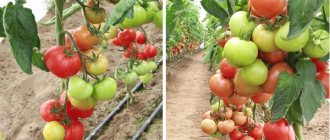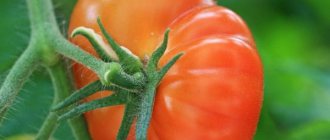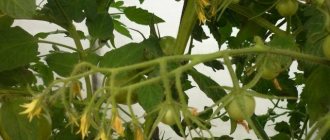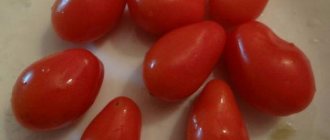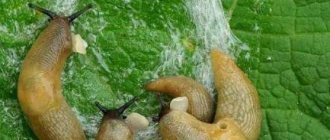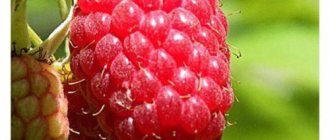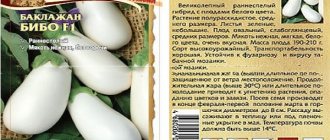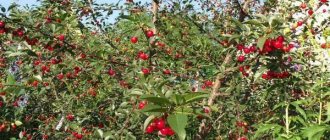The mid-late, non-repairing variety Zorenka Altai was bred specifically for cultivation in harsh climates. Winter-hardy, with large and fragrant fruits, raspberries do not cause any special problems in cultivation, for which they are loved and revered by Russian gardeners, especially those who cultivate berry bushes in areas of unsustainable agriculture.
Description of the variety
8-800-35-08-473 - free hotline for legal assistance on land law issues: dacha amnesty, registration of property rights (purchase and sale, inheritance, mortgage), settlement of disputes with neighbors, change of land category
The Zorenka Altai variety was bred at the Siberian Horticulture Research Institute named after. Mikhail Afanasyevich Lisavenko by crossing wild forest raspberries with the Vityaz variety.
The shoots of this raspberry are tall, powerful, spreading, with a characteristic waxy coating. By the time of cold weather, they become their usual brown color, flexible, and bend down to the ground without difficulty. There are not many thorns and they are soft, located mainly in the lower part of the bush. The shoot-forming ability of this variety is average, but it allows you to easily propagate the crop by root suckers.
Altai Zorenka is included in the State Register for the North-Western, Central, Volga-Vyatka, West Siberian and East Siberian regions.
The berries of Zorenka Altai are light red, weighing up to 4-5 g. They have good adhesion of the drupes and, as a result, excellent transportability. The first fruits usually appear by mid-to-late July, for which the variety is considered mid-season. The berries are endowed with a pleasant sweet and sour taste. Good fresh, as part of all kinds of desserts and preparations. Tasting score 4.5 out of 5.0 points.
The yield of the variety is average - up to 3 kg. from one adult plant, 30 c/ha.
Raspberry traditional variety “Zorenka Altai”
The bush is powerful, medium spreading, with average shoot-forming ability.
Mature plant size
Decorative all season.
Flowering and fruits
Medium sized berries (2.8-3.0 g).
Remainings valid as of: February 19, 2021, 11:29
To choose the right site for raspberries, you need to take into account some of its features. This crop needs nutritious soil and good lighting. Bushes do not like strong winds, so you should choose a place that will be protected by trees, a house or a fence. Moreover, this will give raspberries the opportunity to more easily endure cold winters. But try to ensure that protecting objects do not create a shadow at the planting site. It is best to plant raspberries there. where dill, beans, garlic, onions, beets, carrots, and calendula used to grow. When preparing a site for planting a raspberry tree, it is good to grow legumes and cereal grasses on it: clover, timothy, alfalfa, wheatgrass, vetch - these plants not only improve the structure of the soil, but also enrich it with nitrogen. Lupine is also an excellent precursor for raspberries, which helps clear the soil of May beetle larvae, which cause great harm to plantings. It is not recommended to plant raspberries where potatoes, peppers, physalis, tomatoes, eggplants or strawberries previously grew.
Raspberries require several feedings during the growing season. The generally accepted feeding scheme is as follows: in the spring - nitrogen fertilizers, during the period of flowering and ripening of berries - complex mineral fertilizers, which contain potassium, nitrogen and phosphorus. immediately after harvesting - phosphorus-potassium. and by the end of the growing season - only phosphorus. This crop loves organic fertilizers, so in the spring it is worth making liquid fertilizers from rotted manure or bird droppings. You can feed raspberries with saltpeter or urea: in the spring, until mid-June. A single dose is 60-100 g per 1 m2, but fertilizer can be applied in parts, in 2-4 doses. Fruiting raspberry shoots take 2 years to develop. In the first year, annual shoots grow from the buds on the rhizome, and in the second year a crop is formed on them, after which the branches die. New shoots appear instead of old ones, which is why you have to constantly prune raspberries. If you grow bushes in an ordinary way, then for 1 linear. m (up to 40 cm wide) we leave 5-8 of the healthiest and strongest young
Medium ripening raspberry variety. Originator: Research Institute of Horticulture of Siberia named after. M.A. Lisavenko. Seedling from open pollination of a hybrid of a wild local form and the Viking raspberry variety. The raspberry variety is winter-hardy. Affected by purple spotting. The berries are one-dimensional, red, with strong grip on the drupes, tasty, and transportable. The berries hang on the shoots for a long time, are not susceptible to gray rot, do not overripe or fall off, and are slightly affected by the raspberry beetle.
a brief description of
Zorenka Altai is traditionally famous for:
- large-fruited;
- excellent taste;
- productivity;
- excellent frost resistance;
- good transportability;
- The fruits do not fall off when ripe.
The disadvantages of the variety can be considered:
- presence of thorns;
- susceptibility to purple spotting;
- tendency to be affected by the raspberry beetle (in the absence of timely pest control measures).
Zorenka Altai raspberries do not require staking to trellises, since the variety does not have a tendency to droop.
Landing
Zorenka Altai raspberry prefers well-lit areas of the garden, with fertile soil and deep groundwater. It is sensitive to drafts, so it is given places protected from gusty winds by buildings, plantings or other barriers.
The variety is best planted after legumes and cereals, which make the soil as loose as possible and enriched with nitrogen. But after other berry plants and nightshades, raspberries grow poorly and often get sick.
Altai Zorenka is planted in pits and trenches located 1.5 m from each other and up to 0.3 m deep. A nutrient layer is laid on the bottom, and the seedlings themselves are shortened to 30 cm for better survival in a new place. When planting, the rhizomes are thoroughly straightened, the soil is compacted around the stem. Planted young raspberries are moistened and mulched.
Growing and care
The conditions for growing raspberries of this variety are dictated by harsh natural conditions, but do not differ much from traditional agricultural techniques.
Watering
The Zorenka Altai variety is tolerant of lack of moisture. However, to obtain good yields, raspberries should be watered regularly and abundantly. During the season, up to 8-10 waterings are traditionally carried out.
Excess moisture is much more destructive than its lack. During periods of prolonged rain, some gardeners make special canopies in order to prevent the rotting of rhizomes and preserve the existing crop.
Trimming
Raspberries need periodic thinning. This allows you to protect the crop from thickening, fungal infection and crushing of the berries.
Pruning is done twice a year: in spring and autumn. Each of them pursues its own goals.
Autumn pruning is one of the stages of preparation for the winter period. It is carried out in October, when the night temperature is already below zero. All fruit-bearing shoots are removed, as well as stems affected by pests and diseases. All “one-year-olds” bend down to the ground in order to be protected by snow cover in winter.
In the spring, all broken and frozen shoots are removed, the tops of the remaining trunks are shortened by 0.2 m. The bush itself is thinned out, leaving no more than 10 stems. Spring pruning is done before the snow melts and serves as a stage in preparing raspberries for the new season, helping to increase yields.
The raspberry tree needs periodic updating. After 15 years of growing in one place, it is customary to transfer it to another site.
Top dressing
Zorenka Altai raspberry is sensitive to fertilizer application. Without proper nutrition, it bears little fruit and the fruits are small. The crop is fed several times per season.
In the spring, nitrogen fertilizers are applied, for example, urea (up to 80 g per meter). Before flowering and fruit set, the crop requires complex mineral compositions, and after harvesting - phosphorus and potassium. In mid-autumn, in preparation for winter, additional phosphorus-containing fertilizers are applied. The latter help annuals to lay flower stalks for the next season, and also allow them to more successfully endure a period of prolonged cold weather.
Since raspberries are very responsive to the addition of organic matter, in the spring they are mulched with rotted manure, compost, humus, and peat. Instead of carbamide or urea, it is permissible to add a liquid solution of mullein or bird droppings.
Preparing for winter
Biennial stems are cut out in the fall, and annual stems are bent to the ground. Heavy snowfalls prevent the variety from freezing. However, if the bending procedure is not followed, the tops of the stems will stick out above the snow crust and may suffer from severe frosts.
The cut shoots are removed from the site and burned. They do this in order to prevent the development of all kinds of raspberry diseases. It is not recommended to leave stumps during such pruning, since pests and fungal infections may remain in them. It is also undesirable to use ash from burning old branches to fertilize the site.
When caring for the Zorenka Altai variety, there is no need to use chemical means to control pests and diseases. It is enough to fulfill the simple requirements of agricultural technology.
LiveInternetLiveInternet
Quote from arovana
Read in full In your quotation book or community!
Raspberries: what to plant, how to grow
(Homestead farming No. 2, February 2008)
Raspberries are grown everywhere. And practically using the same technology. But if in the middle zone and in the south plants overwinter without shelter, then in the Urals and Siberia they need to be bent down. But even in snowless winters, raspberries freeze. Therefore, it is important to choose the most winter-hardy varieties. Let's talk about raspberry agricultural technology and varieties suitable for harsh conditions.
In the Urals
Weather conditions do not allow many varieties of raspberries to be grown in the Urals. This means that it is necessary to plant the best varieties in terms of economically valuable characteristics, the most adapted to the local climate.
I would like to tell you about some of the results of our tests.
In the group of early ripening varieties with the control variety Novost Kuzmina, Zorenka Altai varieties selected by the NIISS named after. M.A. Lisavenko and Amateur Sverdlovsk of our selection.
In the group of medium-late ripening, the varieties Kolokolchik, Seyanets Rubinovoy (NIISS), Kichinovskaya, Kirzhach (VSTISP), Tourmaline (our selection) were compared with the control variety Vysokaya (our selection).
Records and observations were carried out for three years. The varieties were evaluated for winter hardiness, yield, berry quality, and resistance to pests and diseases.
First, a few general comments. It is known that the condition and productivity of raspberry plants are largely determined by overwintering conditions and weather during the growing season. Intensive growth of raspberry shoots usually ends in the first to second ten days of August. The abundance of rain during this period retards the growth and ripening of tissues. And severe (up to 28°) frosts in November and the absence of snow lead to serious winter damage to raspberry shoots.
The best winter hardiness was shown by the varieties Zorenka Altaya (freezes by an average of 1 point), Vysoka (1.4 points). Seyanets Rubinovaya , Kolokolchik, Kirzhach, Kichinovskaya, Lyubitelskaya Sverdlovskaya, Novost Kuzmina froze slightly more strongly (2.3 points) . In the Tourmaline , most of the branches froze. Note: this variety has the ability to compensate for the partial loss of fruit buds by developing powerful fruit branches in the surviving upper and lower parts of the shoots.
In terms of yield, the best of the early varieties was the Zorenka Altai . There was no significant difference in yield in mid-late varieties compared to the control.
Large-fruited varieties remain the most popular among gardeners. So, in the early group, the largest berries (2.2 g) were produced by the Zorenka Altai , in the late group - Tourmaline (2.8 g).
of the Novost Kuzmina, Zorenka Altaya, Lyubitelskaya Sverdlovskaya, and Kolokolchik varieties received the highest marks during the tasting (4.3-4.1 points). The remaining varieties had berries of good taste.
If we talk about the appearance of the berries and their transportability, then in these indicators Tourmaline surpasses all varieties; its berries with firmly attached drupes do not lose their commercial qualities during transportation and storage.
Another important requirement for varieties recommended for cultivation is that they must be highly resistant to dangerous and common pests and diseases.
As is known, the raspberry beetle is the most harmful to plants. What is the degree of resistance of varieties to this pest?
In the group of early varieties, the most damaged berries were found on raspberries of the varieties Lyubitelskaya Sverdlovsk (32.4%) and Novost Kuzmina (30.1%), less than others, on Zorenka Altai (17.1%).
In the group of late varieties, the largest number of damaged berries was found in Vysokaya (22.8%), Kichinovskaya (19.8%), and Kolokolchik (16.4%). Tourmaline variety showed high resistance to the raspberry beetle (only 4.7% of the berries were damaged).
If we talk about plant resistance to diseases, the picture emerges like this. The variety Seyanets Rubinovaya turned out to be the most tolerant to didimella (0.5 points). Lyubitelskaya Sverdlovskaya, Kolokolchik, Kichinovskaya, Tourmaline were more strongly affected by it (2.5-3 points). The remaining varieties studied were slightly affected by Didimella.
Damage to raspberry leaves by anthracnose was noted only in the varieties Tourmalin, Kichinovskaya, Novost Kuzmina (2-2.3 points).
Thus, the early ripening variety Zorenka Altai has proven to be the most promising for cultivation in the Middle Urals .
We think that the raspberry varieties Kichinovskaya, Kolokolchik (mid-late), Tourmaline (late) are of interest to gardeners, if we keep in mind the size of the berries.
G. Andreeva , Sverdlovsk Horticulture Breeding Station, Yekaterinburg
In the middle lane
I started working seriously with raspberries twenty years ago, tried different methods of cultivating them in different areas and came to the following conclusions.
Particular attention should be paid to the quality of seedlings. The shoots should be as thick as possible, preferably with a diameter of at least 5 mm, and the root system should be branched, horizontal roots are required. Do not purchase twig seedlings with only vertical roots. They are weak and will take a long time to grow. Try not to buy unpruned seedlings, with whole shoots and especially with leaves. A standard seedling should be about 20 cm high. The survival rate of such seedlings is better and they are easier to transport. If you come across seedlings with a long shoot, cut it off immediately, do not regret it.
Short seedlings are good for one more thing. In the first year, they do not waste energy on the old shoot, a sufficient number of new ones grow, so that next year you will have a quite bearable harvest. Do not try to get berries in the first year, especially white ones, if you are sure of the purity of the variety. In the first year there will be only five berries and few shoots, in the second year there will also be a handful of berries, that is, you will lose a year. To prevent this from happening, pick off the flowers the next year after planting.
When purchasing planting material, inspect it for pests and diseases. If something confuses you, reject the material. If the shoots are thin, then there is a high probability that they are affected by viral diseases (witch's broom, growth, etc.). Fungal diseases are quite common. Some of them (anthracnose, etc.) will probably be present on the seedlings. In addition, with the current attitude of most gardeners towards raspberries, the introduction of infection from neighboring plots is practically guaranteed within 1-2 years.
Pay attention to the roots. There should be no swelling on them; this is a symptom of a nematode or root cancer - the seedling may die. In addition to the raspberry beetle and weevil, there are more dangerous pests, although they are less noticeable. If there are galls on the seedlings or there is a small longitudinal wound slightly (2-10 cm) above the root collar, reject such plants immediately.
Raspberries are a plant of forest edges, which means they need a sunny, quiet and humid place. I planted raspberries both in the old 40-year-old garden and in a new, almost bare, windswept place using almost the same technology. In the first case, the shoots grew to 3-3.5 m. The harvest from a plot measuring 4x5 m was no less than 8-10 buckets. On the new plot, the shoots grew 1.5 m long. I collected raspberries from a plot twice as large and with new varieties from only 2 buckets. Thus, in a blown area, even with the correct agricultural technology, it is useless to expect long shoots and a large harvest from raspberries.
You should not be embarrassed by the height of the shoots. The number of fruit branches from a bud and the number of berries per branch within a variety are constant, so the yield can only be increased by lengthening the shoot.
The soil should be sufficiently loose and nutritious. On sand, raspberries will suffer from a lack of moisture and some nutrients, on very dense soil - from a lack of air in it and, again, from a lack of moisture. The roots will be located in a thinner layer and higher than usual.
The best option is a separate place for raspberries, sheltered from the winds and sunny, but not close to the fence. Because the neighbors will most likely weed out your raspberries that have entered their plot using all means, and the plant does not like this. It is necessary to retreat at least 1 m from the fence. In addition, a picket fence, even a loose one, blocks the light, and the harvest is reduced. And the boundaries between the plots are usually covered with grass, and raspberries, as you know, love moisture, and here, near the fence, it will not have enough moisture. And picking berries near the fence is more difficult.
It is better to place even one row of raspberries from north to south, while the illumination is better and more uniform within the bushes. This is especially important if there are several rows.
At the new site, I received raspberries from the previous owner, planted near the fence along the road on the lower part of the southern slope. I've been watching these raspberries for three years now. The harvest is quite good.
This seems to refute my opinion about the undesirability of planting close to the fence. But... The picket fence is on the south side, that is, it provides the plants with some protection from the south wind and the sun. On the northern side up the slope, plums and cherries are planted. They block the raspberries from the north wind and, together with the fence, contribute to the accumulation of snow in winter. Snow is very important for overwintering plants and for accumulating moisture in the soil. The soil, even without heavy rains last year in the spring, was wet until mid-June. The trees are planted higher up the slope and do not block the light from the raspberries. It turns out that she is, as it were, in the corridor. The option, of course, is not ideal, because the raspberries are planted in one row. Bushes located at least half a meter from the fence and a meter from the trees feel better.
I abandoned the so-called stake method of planting raspberries, although many people use it. My experience speaks in favor of the trellis. This way, the bushes are trampled less during berry picking, the shoots grow more freely, and it’s easier to pick berries. Another advantage of the trellis is that it makes it easier to repair plantings. An old or diseased bush can be uprooted, the ground cultivated, and in a year or two this place will be filled with shoots from neighboring bushes.
I use a regular horizontal trellis. Raspberry shoots are quite massive, and therefore, in order for the trellis to withstand the load, it is better to make all parts metal. And the trellis itself should look like the letter H, then the outer pillars will tilt less in the row. There is no point in increasing the height of the trellis beyond 1.5-1.7 m. The wire for horizontal tension is steel, 3-4 mm thick, strong and durable. One of the wires is stretched at a height of 1 m, the other - 1.5 m. To make the structure rigid - to stabilize the trellis in a row, instead of wire, reinforcement with a diameter of 8-12 mm can be laid at the top. True, it has a drawback - it is corrugated. The shoots, no matter how you tie them, under the influence of the wind will rub against its ribs and become damaged. So it’s better to take a pipe with a diameter of 10-15 mm for this.
I tie the shoots directly to the wire, using wire as fastener, but aluminum or copper insulation. It is quite soft and at the same time durable, it lasts for many years, it is easy to remove and, if necessary, bandage the plants.
The distance between the rows, if there are several of them, is 1.7 m, but it is better to do 2 m each. I planted raspberries every 1.5 m - this turned out to be not enough. In the middle of summer, if the plants develop normally, the rows close completely, so that it is almost impossible to get through them. I know that sometimes they pull two wires on each tier and the shoots are placed between them, but this method seemed less convenient to me. The best trellis is the T-shaped one, but it is more difficult to make.
I also tried the system of keeping plants separate. Its essence is that in two raspberry plantings located in different parts of the garden, either only fruit-bearing shoots are left, or only green ones. With this scheme, the light regime improves, and, consequently, the quality of the berries and the plant’s strength are spent on one thing - fruiting or the development of new shoots. On green shoots, shoot gall midge can be controlled using chemical methods throughout the season.
If you have ordinary garden soil, then it is enough to dig trenches measuring 50-70 cm to a depth of 50 cm and fill them with mineral and organic fertilizers. The land should be clean of perennial weeds, especially rhizomatous ones - wheatgrass, sow thistle. Some gardeners, in order to reduce the time it takes to develop a plot, plant raspberries in turf and then cultivate the rows.
There was a time when I planted wheatgrass and the result was disappointing. Wheatgrass rhizomes are located practically in the same soil horizon as raspberry roots, which means there is competition for nutrition and moisture. In the future, it is very difficult to free the plantings from weeds, and the raspberry rhizomes are often damaged. Therefore, it is better to waste a year cleaning the site than to suffer for several years later weeding the raspberry bush.
I read that raspberries are responsive to magnesium. I added an additional 2 tbsp. spoons of magnesium sulfate per 1 m of trench.
How effective this is, I can’t say for sure, but I will note this fact: after 5 years I re-applied approximately 1 tbsp. spoon on 1 m row, and the quality of the berries has improved. In addition, for several years the raspberries did not spread beyond the trench. The explanation here may be this: the roots did not go to the side because they had enough nutrition.
To prevent raspberries from “walking” around the garden, you need to bury some dense material vertically to a depth of 40 cm. Flat and corrugated slate, sheet iron, and various plastics are suitable. Ruberoid, even in 2 layers, is not effective. The raspberry roots literally “pierce” it. There should be at least 1 m from the plants to the limiter, and the limiter itself must be installed -10 centimeters above the soil level, so it will be convenient to cultivate the soil and mulch it.
It is better to plant raspberries in the fall. I plant it every 50 cm, after 2-3 years the offspring fill the space of the row. There are recommendations to place 2 raspberry seedlings in one planting hole. This makes sense if the seedlings are weak and you have doubts about their survival rate, and also if they are not purchased, but taken from friends, that is, verified.
Raspberries are one of the most moisture-loving crops. But you need to water it evenly, especially during the ripening period. Otherwise, the berries will become soggy and their taste will deteriorate. Late autumn watering is very useful.
Raspberries are the only plant in the garden that almost completely renews the vegetative part within a season. It needs to be replenished. In any case, the usual application of nitrogen fertilizers in the spring, and potassium and phosphorus or complete fertilizers in the fall is mandatory. Raspberries respond very well to foliar feeding until mid-summer with urea and microelements - boron, molybdenum, zinc, manganese.
D. Golov , Penza
https://sadisibiri.hop.ru/malin-reg.html
Reproduction
Raspberry Zorka Altai forms a moderate number of shoots. There are not many of them, which facilitates the process of dealing with excess shoots, but there are quite enough to propagate the variety precisely by root suckers. Young shoots are planted mainly in the spring, so that during the season they have time to start growing, get stronger and prepare for the cold period.
For planting, only healthy and strong shoots are used, without signs of damage by pests or diseases. They are separated from the parent plant with a lump of earth and transferred to a permanent place. The holes for seedlings are prepared a couple of weeks in advance. Their maximum depth is up to 30-40 cm. Organic matter is laid in the bottom layer, then mineral fertilizers and ash. All this is sprinkled with a little soil. After planting, the seedlings are thoroughly watered and mulched.
To preserve moisture in the soil, as well as to block the growth of weeds, it is advisable to mulch the raspberries
In addition to shoots, the method of propagation by root cuttings is very common. To do this, dig up the raspberries a little in the spring and separate the large roots (no smaller in diameter than a pencil), which are cut into segments approximately 20 cm in length. The latter are placed in containers with fertile soil, which, for faster results, are placed in a greenhouse. It is better to put them in a greenhouse for better growth and development. By autumn, a lot of young shoots will appear, which are transferred to a permanent place of growth.
Medium ripening varieties of remontant raspberries
Velvet
The variety is not susceptible to low temperatures. Productivity is high and stable. The berries are red, juicy, sweet, and can be transported. They can hang on bushes for a long time and not be affected by gray rot. The bushes grow medium-sized, semi-spreading. The shoots are densely covered with soft thorns, so they seem soft and velvety.
Tourmaline
Belongs to large-fruited varieties. If you take the trouble to bend down the shoots for the winter, they will survive the winter just fine. Very large pink-red berries, tasty, dense, easy to transport. After the harvest ripens, the berries stay on the bush for a long time and do not fall off. They ripen late, which prolongs the raspberry season. The shoots do not grow tall, are plastic, and without thorns. It works well when grown on a trellis, because the weight of the fruit can cause the bushes to break. Sometimes the variety freezes slightly, but quickly grows due to the fruit branches in the upper part of the shoot. The variety is resistant to pests.
Reliable
The name of the variety speaks for itself. According to data obtained from various regions of Russia, the Nadezhnaya variety turned out to be one of the most reliable and stable. In any weather, even with not very good care, it regularly produces yields of 3-3.5 kg per bush. The berries of Nadezhnaya are blunt-conical, calibrated, red, with a shiny surface, weighing 3-4 g. The taste and aroma of the berries of this variety is one of the best among the varieties of remontant raspberries. The berries can hang on the bushes for a very long time, up to 2 weeks, without being damaged or losing their appearance. The bushes are very strong and non-lodging.
Apricot
The variety has amber berries with a pink blush and an apricot flavor. They delight not only children, but also seasoned adults. This hard worker raspberry begins to ripen in August and bears fruit until frost. Before this time, you will have time to collect up to 4 kg of berries. Semi-spreading bushes of medium height. The thorns are located mainly in the lower part of the shoots, so they do not interfere with caring for and harvesting.
Evening dawn
A high-yielding, very promising variety of remontant raspberries. The shoots of the Dawn of Evening are strong and do not lie under the crop. The bush is open and well ventilated, which prevents the berries from rotting in wet weather. There are practically no thorns on the shoots, which simplifies care and harvesting. Evening Dawn berries are conical in shape, bright, dense, with a very good taste and aroma. The weight of berries in the first pickings is 4-6 g. The variety is characterized by uniform yield and high resistance to drought.
Autumn beauty
The bush is compact, up to 1 m high. The berries are closer to large ones - 3.5-4 g, easily removed from the fruit, excellent taste. The beginning of ripening is the end of August. The height of fruiting is September 10-15. The variety is distinguished by its rapid ripening and very high yield - 5-7 kg per bush. Under such weight, even strong shoots of this variety bend in an arc.
Daughter of Hercules
The daughter of Hercules inherited the most valuable qualities from her famous father. Large, ripe, refreshing berries with a subtle hint of sourness will appeal to even gourmets. This variety is very resistant to major diseases and pests. The berries are remarkable not only for their huge size, but also for their dense consistency. After deep freezing, these raspberries retain their shape and taste. And it looks like it was just plucked from a bush. The daughter of Hercules is able to decorate any dessert dish even in the cold season. Don't pay attention to the hard, prickly thorns! They are not for you! Enjoy an exceptionally tasty harvest, it is stable every year! This variety has received recognition for its very large, beautiful berries, stable yields, upright bush habit, and resistance to major diseases and pests.
Atlant
This variety occupies a special place among the varieties of remontant raspberries. Atlas resists numerous diseases and pests better than others. Has excellent growth qualities. Its shoots grow up to 2 m, but do not need to be tied to a trellis. Thanks to its powerful root system, Atlant is one of the most drought-resistant raspberry varieties. Atlant produces a moderate amount of growth, which simplifies the care of plantings. Already in the first year after planting in Atlanta, you can get a significant harvest. The first berries ripen in mid-August. After this, the yield of the harvest proceeds very quickly. By mid-September, the harvest from one bush with good care is up to 5 kg. At the same time, the quality of the harvest remains ideal until the last harvest: the berries are large, 5-6 g, aligned, dense, have an attractive regular elongated conical shape, are easily separated from the fruit, and can hang on the bushes for a long time without losing their presentation. Atlant is one of the most delicious and aromatic varieties of remontant raspberries. Moreover, the berries have good taste and aroma, ripening even in cold and rainy weather.
Elegant
A very promising variety of remontant raspberries. It is distinguished by early ripening of berries and very high yield. One bush of the Elegant variety can produce a harvest of over 4 kg. The variety got its name for its very beautiful elegant berries. Their color is bright red, their shape is cone-shaped, regular, their surface is shiny, their weight is up to 4.5 g, their taste and aroma are good. The bush is powerful, durable, non-lodging.
Ruby necklace
This is just a phenomenal variety! Reddish-purple shoots effectively set off the expressive color of the berries. Impossible to resist! A ruby necklace will become a real precious decoration for your garden! The berries are bright red, large (weighing up to 9 g), beautiful, elongated cylindrical in shape. The taste is sweet and sour, refreshing. The berries are good fresh and suitable for all types of processing, including deep freezing.
Augustine
One of the varieties that are recommended for regions with short and cool summers. The berries are attractive in appearance, bright red, large. The yield from one bush is up to 1.5 kg, which is lower than that of other varieties of remontant raspberries (Hercules, Indian Summer-2). But due to the fact that Augustine has a compact, low bush and allows denser planting than usual, its yield per unit area is not inferior to the best varieties in terms of yield.
Firebird
This is a slightly spreading bush, the shoots of which reach up to 1.9 m in height. The stems are green, dense, spiny. The spines, soft and thin, are concentrated in the lower and middle parts of the shoot. The leaves are medium in size, ripe berries are purple-red in color, usually medium and large, reaching a weight of 4-6 g. Their dessert taste is remarkable: fresh, sour-sweet with a well-defined traditional aroma. The cone-shaped shape of the fruits and their bright color are very decorative; bushes sprinkled with red berries really resemble the fabulous Firebird, decorating the site and delighting the gardener.
Monomakh's hat
The bush is low (up to 1.5 m) in the form of a raspberry tree, consists of 3-4 powerful, slightly drooping, highly branched shoots. It is distinguished by unusually large berries. On the plots of amateur gardeners, with good care, berries weighing up to 20 g (the size of an average plum) ripen. Productivity is very high - up to 5.5 kg per bush, that is, almost a full bucket!
Hercules
This is the most popular variety of remontant raspberry. Large-fruited - the berries in the first pickings reach 8-9 g, high, stable yield - over 3 kg per bush, Hercules combines with unpretentiousness, high resistance to major diseases and pests. The bushes are strong and do not lie under the crop.
Golden autumn
Large-fruited variety of remontant raspberry. First of all, Golden Autumn amazes with the size and appearance of its berries. They are not just yellow - they are golden, bright, shining in the sun, translucent. The weight of the berries is 4-6 g, and with good care up to 9 g. In the conditions of a personal plot in Golden Autumn, you can get a harvest of up to 4 kg of berries per bush.
August miracle
Raspberries of this variety are high-yielding, the yield from its shoots can reach from 6 to 9 kg per bush, and per hectare it can produce up to 11 tons of berries. The berries are medium in size, weighing up to 4.5 g, but abundant fruiting allows you to get a generous harvest. The bush reaches a height of 175 cm, its stems are straight and powerful. The inflorescences, and then the berries, are located along the entire height of the plant, except for its very lower part. The August miracle gives people their harvest before the frost begins. It is distinguished by the most intense fruiting at the beginning of the season. This variety has excellent winter hardiness: it can withstand up to 29 degrees of frost, if the plant was properly cared for in the fall. The advantage of the August miracle is complete immunity to insects that parasitize raspberry bushes. It is devoid of worms and does not suffer from various spots. The August miracle is grown on an industrial scale in the central and northern parts of Russia.
Bryansk miracle
Bryansk miracle is a promising variety of domestic selection. This raspberry has powerful, thick stems with thorns, but the branches on the sides are thornless and have a waxy coating on them. The bush is slightly spreading, it does not require tying, but in case of sharp gusts of wind it is still better to do this. The plant has a small amount of root shoots. The Bryansk miracle bears fruit for a long period, it begins in the second half of August. Annual stems bear fruit until the end of the season. Cold resistance is up to 24 degrees below zero. When this raspberry bears fruit, you can have up to 3 ½ kg from each plant, and from 1 hectare it is up to 13 tons. The berries reach a size of 5–7 g, but some of them can grow up to 11 g. The berries are large, elongated, red and sweet with a slight sour aftertaste. The fruits have increased density, so they are easy to transport and store for a long period. Based on the totality of its characteristics, Bryanskoe Miracle is an effective industrial variety.
Diamond
The Brilliantovaya variety bush is not tall: it grows only 1–1.2 m, less often up to 1 ½ m. Its shoots have a waxy coating and a small number of thorns. Ripe berries grow up to 4 g, are shiny, and have a slightly sour taste. The pulp is juicy, but tolerates transportation well and also has excellent keeping quality. Diamond raspberries bear fruit actively; if conditions are favorable, you can collect up to 8 kg of berries from one plant. The harvest ripens from the beginning of August until frost. The winter hardiness of the bushes is up to -24 degrees. The peculiarity of Diamond is that it bears fruit in the form of clusters, so it must be regularly periodically fed with organic matter or mineral fertilizers.
Orange miracle
The Orange Miracle raspberry bush has tall, spreading shoots. Up to 7 replacement stems and basal shoots are formed in the plant. There are many thorns on the branches of the plant, which can, to some extent, make harvesting raspberries difficult. The fruits have an oblong shape, up to 4 cm long, they weigh 4 ½ -5 ½ g, but some grow up to 10 g. There is a noticeable raspberry aroma, there is sourness in the taste, the color of the berries ranges from yellow to bright orange. The harvest can be harvested from each plant up to 3 kg. Before frost, all the raspberries usually have time to ripen. The fruits have a velvety surface, and their pulp has increased density. Orange miracle raspberries are productive, easily transported, and can be stored for a long time, so they are quite suitable for commercial cultivation. The bush of this variety has good resistance to parasitic insects and diseases, but can suffer from severe frosts and heat. Frost resistance is up to -24 degrees.
Reviews
An excellent variety for the Urals and Siberia. I don’t really trust modern varieties, many of which are imported from other countries where they may have never heard of frost. There are now a lot of seedlings being sold in chain stores, but again the question is: where does all this come from? And Zorenka has been growing for me for a long time, a proven variety, tasty and winter-hardy. They don’t look for good from good, so I will continue to grow it.
“Zorenka Altai” showed itself to be excellent in the conditions of Siberia, where I live. I bend it over in the fall, cover it with non-woven material and it winters well with me. And we have frosts of minus 40 for a long time, but so far not a single course has frozen out.
Zorenka Altai raspberries are recommended for cultivation in harsh climates. It is very responsive to fertilization, timely watering, and loosening. Due to its susceptibility to purple spot, it requires attention during the growing season. The variety is winter-hardy, however, in extreme cold the tops of young shoots may be damaged - they must be bent to the ground.
The best raspberry varieties for Siberia
Breeders use all their skills and knowledge to promote raspberry varieties further to the North and satisfy gardeners’ needs for tasty and juicy summer berries. The varieties must have high taste, as well as not freeze and withstand periods of drought.
Most Popular
- Early sweet – ripens quickly, has increased resistance to Siberian frosts;
- Ogonek Siberian - the fruits are delicious and delight with high taste qualities;
- Barnaulskaya - has earned the respect of gardeners in Siberia and the Urals for its high frost resistance;
- The reward will delight you with juicy and aromatic fruits; the variety can withstand low temperatures and does not freeze;
- Gift of Siberia - withstands severe frosts without freezing, resistant to pests and diseases.
Early maturing
Faith. Gardeners claim that there is simply no better raspberry variety for Siberia. It has average yields - about 5 kg per bush, but the bush itself is low, semi-spreading. Harvesting takes place over 2-3 harvests, the first harvest being the most widespread. Drought does not affect the quality of the harvest, but when watered, the taste of the berries improves, they become juicier with a pleasant sourness.
The shoots are very well leafy and have an average ability to form shoots. Resistant to pest damage.
Harvest of raspberry variety Vera
Early sweet. A variety of folk selection. The berries are red, small, short-conical. The fruits will delight you with a pleasant taste and aroma, but cannot be transported. The bushes are tall and produce little growth. Annual shoots are spiny, covered with a waxy coating. The spines are short, thin, and purple. Doesn't freeze.
Variety Early sweet on the bush
Average
Brilliant. The berries are raspberry-colored, not very large, aromatic, with a sweet and sour taste, do not ripen at the same time, and are harvested 5-6 times. The fruits hang on the bushes for a long time and do not fall off. Can be eaten fresh, but are also suitable for processing and freezing. The shoots are flexible, the tops bend down, so it is better to grow on a trellis. Two-year-old shoots acquire a brown color and are slightly spiny. The bushes are winter-hardy, resistant to diseases and pests.
Shiny Raspberry
For health. Medium to large berries with carmine color. The pulp has a dessert taste, dense, juicy. The bushes are medium-sized, spreading, and few shoots are formed. Annual shoots are purple and covered with thorns. Needs watering; in dry weather the yield sharply decreases. Raspberries are resistant to spider mites and purple spot.
Gift of Siberia. Very interesting berries - delicate creamy color, pleasant to the taste, last a long time on the bush, dense and aromatic. It is possible to harvest more than once; fruiting is extended. The bushes grow tall and powerful. The shoots that grow during the first year of vegetation are green, and the next year they become brownish. The rod is suitable for growing in harsh conditions and does not freeze.
It is extremely important to choose the right raspberry variety for your plot. Before purchasing, you need to decide what characteristics it should have, the taste of the fruit and the possible purpose of the crop. The most profitable and frost-resistant varieties are considered to be remontant varieties that are grown in a one-year crop. Such varieties will delight you with harvests, unpretentiousness and tasty berries.
The post The best varieties of sweet raspberries for the Urals and Siberia first appeared About the farm.

